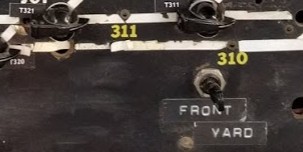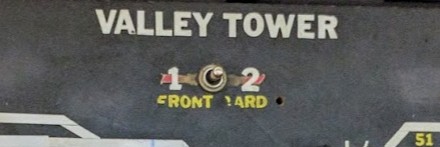The Randall Museum in San Francisco hosts a large HO-scale model model railroad. Created by the Golden Gate Model Railroad Club starting in 1961, the layout was donated to the Museum in 2015. Since then I have started automatizing trains running on the layout. I am also the model railroad maintainer. This blog describes various updates on the Randall project and I maintain a separate blog for all my electronics not directly related to Randall.
2018-02-24 - Mainline Issues
Category RandallRunning under automation is only one aspect for the train model railroad on the Randall Museum.
The other aspect is supporting people who want to run on Saturdays. There are a few challenges to solve here, such as complying with museum requirements and defining our own screening and approval process. That could be tricky since ex-members might want to run as if they were back in their old club, using their old ways.
One point I have been trying to make is that running on this layout is more tricky than it looks. The panels are confusing, labeled yet hard to understand. Most people have the natural bias of overestimating their own proficiency and that is clearly visible when operating this layout. That is why I want to insist in everyone, including ex-members, in having a training before running again yet at the same time there’s little traction for it from said people -- the typical “how hard can it be”.
But before getting there, one issue to address is the lack of maintenance on the mainline.
5913 approaches turnout T322. The point was stuck and throwing it shorted the mainline.
The club had a laissez-faire attitude in its two last years, which resulted in a lot of “deferred maintenance”. In their defence, this is a direct consequence of the museum’s behavior as that mentality shift obviously started when the museum announced them they would lose the room and later dragged them in that never ending demoralizing “contract negotiation” process. Then the whole place sit unused for two years and although we tried to clean the mainline from time to time when we had access, the focus was on the automation.
Needless to say, there are quite a number of non functioning turnouts or electric problems that need fixing, some way beyond my abilities, and my first task was trying to make an exhaustive list of them.
One thing we did try is to make sure the mainline works as a continuous loop, since that’s what most “tail-chaser” people like to use, it’s the bare minimum that should be acceptable, and it’s needed for Saturday operations in public. If we can identify where the problem areas are, we can label them clearly and at least assume the rest works till repairs get done.
The last two sessions with people running on the mainline were plagued by inexplicable electrical problems.
The notes I took on the subject where quite interesting when I combine them in retrospect:
2018-02-15: “No power on mainline anywhere!” That was a bit of an overstatement, let’s say “not in the place where it mattered”. I suggested a workaround which is to set the power selectors on the Valley Tower towards Panel 1 (in hindsight, this was a mistake, see below).
2018-02-16: Throwing T322 (turnout from mainline to branchline) shorts. Turned out to be a defect in turnout T322 where it would stick and not throw properly. Cleaned it up, lubricated the point and then threw it several times seemed to improve the situation.
2018-02-16: Trying to run on B322 from mainline to branchline, the interchange track has no power. This is controlled by a power selector in the branchline drawer which I had misconfigured before closing the drawer (it’s hidden behind the fascia, out of reach of the public hands).
2018-02-17: Shorting on the mainline, every block from B310/311 up to B330.
Wait, again?
That one took me a whole afternoon to figure out as that short would happen or not with no obvious reason. Eventually I found a loose *block power* wire in the *turnout* panel, on a toggle at the bottom named “Front Yard”. It’s obviously a power selector. Don’t know the source nor what it controls, but it had one wire lose with an exposed contact that was shorting depending on how the panel was closed.
That means one more thing to do: understand that toggle and either fix it, label it, or remove it.
2018-02-24: Both Jims having electrical issues on the mainline. The Stockton Yard was shorting, which inexplicably affected the mainline when both are supposed to be on different power districts with each their own circuit breakers (to avoid exactly that). Definitely not right and after several hours trying to understand the panels, I finally figured out: when I changed the “Front Yard” power selector towards the Valley Panel 1 the week before, I basically made a connection between both, thus essentially having tracks powered by both power districts. Not a good thing.
Note: the faded labels on the left really reads “M Y V”, not “M V V”.
That’s the thing with a DC layout: interchange tracks are logically equipped with a power selector to power the track from one side or the other -- e.g. power from mainline, enter the train on the interchange, then power from the yard, proceed to yard. But now we have a combination of somewhat poorly labeled power selectors: on the yard panel on the left each interchange track has a “M Y V” selector (for Mountain / Yard / Valley) and on the valley panel on the right, there’s a Front Yard with “1 2” position. It’s important to realize the problem arises not when one panel is switched, but due to the interaction of both panels which are several feet away and control seemingly different things so there’s no mental connection between both.
Since the layout is never going to be used in DC-only again, these should be removed and each track should be powered only by its own power district, protected by a single circuit breaker. These toggles are remnants from a bygone era and keeping them around is only going to create problems as inexperienced or confused operators randomly flip switches that can potentially short a large section of the layout, without realizing they are even doing so.
So more work to do, but who’s going to do it?



